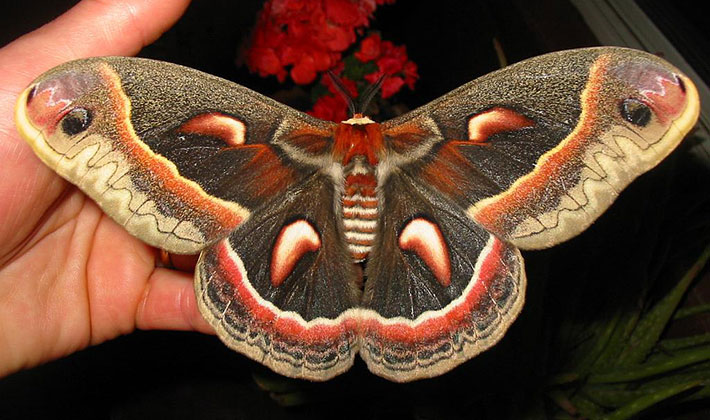
Common Name: Cecropia moth, Robin moth
Scientific Name: Hyalophora cecropia
Season: One generation a year in New England, with adults flying late May into June, and caterpillars from June into the fall.
Food: Many different woody plants in the Northeast: alder, ash, basswood, birch, cherry, dogwood, elm, hawthorn, maple, oak, poplar, wax myrtle, and willow.
Ecology: One of the largest moths in the US, with a very large caterpillar to boot. Unfortunately, this species of moth is in decline, due to a parasitic fly that was initially released to handle gypsy moths, as well as loss of native host plants. Although caterpillars appear to have spikes on their body, they do not sting. Caterpillars will move to the base of host plants and form silken bag cocoons, where they will overwinter.
Doug Tallamy Photo
Keep Your Eye on the Birdie
Field Notes, From the FieldYellow warbler:
Frequently sighted while walking or bicycling lovely Fishers Island.
*Becoming a “summer resident”.
Field Note, From the Field by Justine Kibbe, Aug. 1, 2018
Sitting Amongst Friends
From the Field, Video SnippetsToday’s treasure…
Diverse species of shorebirds feeding within mounds of seaweed washed ashore–the wrack line.
Grateful to say, numbers of birds noted this summer have increased!
Stewardship is as Stewardship does.
Video Snippet, From the Field by Justine Kibbe, July 30, 2018
This Morning with Semipalmated Friends
Field Notes, From the FieldSemipalmated plover
Semipalmated sandpiper
Appreciation.
Western tip of South Beach, Fishers Island.
Field Note, From the Field by Justine Kibbe, July 30, 2018
Cecropia Moth
FI MothsCommon Name: Cecropia moth, Robin moth
Scientific Name: Hyalophora cecropia
Season: One generation a year in New England, with adults flying late May into June, and caterpillars from June into the fall.
Food: Many different woody plants in the Northeast: alder, ash, basswood, birch, cherry, dogwood, elm, hawthorn, maple, oak, poplar, wax myrtle, and willow.
Ecology: One of the largest moths in the US, with a very large caterpillar to boot. Unfortunately, this species of moth is in decline, due to a parasitic fly that was initially released to handle gypsy moths, as well as loss of native host plants. Although caterpillars appear to have spikes on their body, they do not sting. Caterpillars will move to the base of host plants and form silken bag cocoons, where they will overwinter.
Doug Tallamy Photo
Summer’s Beauty on Parade
From the Field, Video SnippetsAn Easterly wind rustles through historic Parade Grounds, this July afternoon.
These meadows are conserved and preserved by The Fishers Island Conservancy-175 acres cultivating & demonstrating native plant species; providing critical habitat and nutrition for insects and migrating birds.
Video Snippet, From the Field by Justine Kibbe, July 21, 2018
2018 Sunset on the Beach a Huge Success!
NewsUniversity of Delaware entomologist, Doug Tallamy spoke to an enthusiastic crowd of over 350 people at FIConservancy’s 2018 Sunset on the Beach Sat. July 21, 2018 at the Fishers Island Club’s Beach Club.
Nature Days 2018: “Conservation on Parade”
Education, Events, NewsFIConservancy’s Nature Days is back! This year, enjoy a Free Family Event Sat. Aug. 11, 3-6 p.m. at the Parade Grounds. Enter through the Demonstration Garden.
Learn about local wildlife through hands-on discovery. Have an up-close visit with a bird of prey, touch turtles and snakes, meet frogs, see and touch feathers, furs and many other natural items.
Don’t miss the ice cream truck, and stop by for wine, beer and lemonade.
Got MILKweed for Monarchs?
Field Notes, From the FieldParade Grounds, Fishers Island.
Monarch Caterpillar feeding on milkweed, getting ready to pupate.
Field Note, From the Field by Justine Kibbe, July 16, 2018
“The Least Terns are Coming! The Least Terns are Coming!”
Field Notes, From the FieldWonderful news for our Island!
Marked increase in observations of least terns this summer. Thank you to the Nature Conservancy Long Island for new informative signage near least tern breeding activity in a unique critical habitat.
Please tread lightly.
Stewardship is as Stewardship does.
Least terns are returning to Fishers Island.
Field Note, From the Field by Justine Kibbe, July 12, 2018
Summer’s Humming Along…
Field Notes, From the FieldI spied this female Ruby-throated Hummingbird
busily zipping about under the canopy of a tall American Elm.
Carrying teeny lichen flakes to prop up her wee nest; she finally rested long enough for a quick click of the camera…
Field Note, From the Field by Justine Kibbe, July 18, 2018